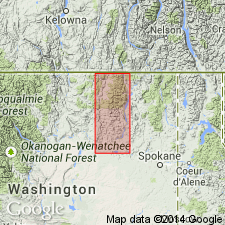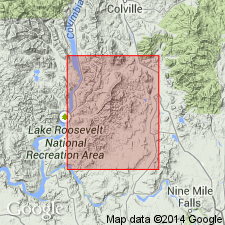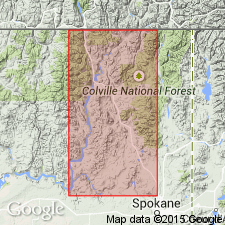
- Usage in publication:
-
- Deer Trail argillite
- Modifications:
-
- Original reference
- Dominant lithology:
-
- Argillite
- Schist
- Phyllite
- AAPG geologic province:
-
- Northern Cascade Range-Okanagan province
Summary:
Pg. 59, map. Deer Trail argillite. Argillites, calcareous argillites, phyllites, quartz mica schists, narrow bands of limestone, and small discontinuous bands of quartzite; argillites and quartz-mica schist are most abundant. Thickness 3,000+/- feet. Includes Stensgar dolomite member. Underlies Addy quartzite. Age is Paleozoic.
[Type locality not stated, but Deer Trail Mine is in this formation.] Recognized in Stevens Co., northeastern WA.
Source: US geologic names lexicon (USGS Bull. 896, p. 589).

- Usage in publication:
-
- Deer Trail group*
- Modifications:
-
- Revised
- AAPG geologic province:
-
- Northern Cascade Range-Okanagan province
Summary:
Pg. 7-8. Referred to as Deer Trail group. Includes Stensgar dolomite. [Age is considered Precambrian (Belt series).]
Source: US geologic names lexicon (USGS Bull. 1200, p. 1072-1073).

- Usage in publication:
-
- Deer Trail group*
- Modifications:
-
- Revised
- AAPG geologic province:
-
- Northern Cascade Range-Okanagan province
Summary:
Deer Trail group. Described as a group consisting of a series of metasediments, probably of Beltian age, composed dominantly of fine-grained clastics with minor amounts of quartzite and dolomite. Thickness 5,000 feet. Includes (ascending) Togo formation, Edna dolomite, McHale slate (all new), Stensgar dolomite, and Buffalo Hump formation (new). Unconformably underlies Huckleberry group (new). [Age is considered Precambrian (Belt series).]
Source: US geologic names lexicon (USGS Bull. 1200, p. 1072-1073).
For more information, please contact Nancy Stamm, Geologic Names Committee Secretary.
Asterisk (*) indicates published by U.S. Geological Survey authors.
"No current usage" (†) implies that a name has been abandoned or has fallen into disuse. Former usage and, if known, replacement name given in parentheses ( ).
Slash (/) indicates name conflicts with nomenclatural guidelines (CSN, 1933; ACSN, 1961, 1970; NACSN, 1983, 2005, 2021). May be explained within brackets ([ ]).

